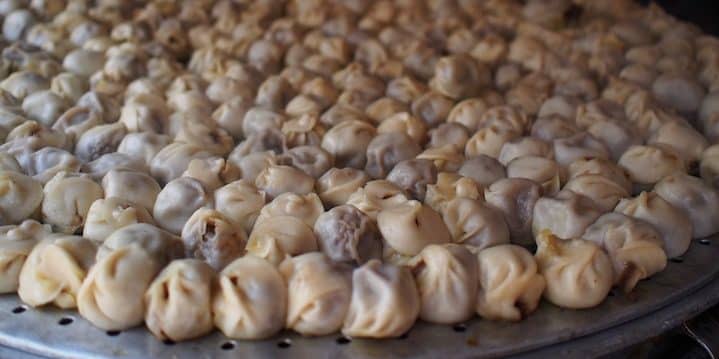
It is just after lunchtime in Kathmandu and the sun is beginning to sting my skin. The heat of early Nepali summer is no joke. The sleeves of my buttoned-up shirt are rolled back, and my leather shoes are losing their shine in the dusty, frantic streets of this sidewalk-less city. Sweat escaping through my face and forearms is collecting dirt and exhaust kicked up by whizzing motorbikes, which one after the other swerve just around us, just in time. Cathy and I walk single-file for safety as we attempt to hail a cab.
The badges swinging from our necks relay that we belong to Nepal’s first-ever Himalayan Travel Mart, but on this day we have escaped to plunge deeper into the rollicking, spilled-over soul of our host country. So far, I have eaten 40 momos—the country’s beloved dumplings—by myself. Cathy has finished not a single plate of ten, so on second thought my number is probably closer to 50. This was more or less the plan.
An accomplice in a mud-stained taxi slows to assist, meeting our gaze to request a destination through the passenger-side window. We have none, and we tell him so through smiles stretched wide with adrenaline. We are on an improvised hunt for Kathmandu’s best momos and we would like him to deliver us to his favorite spot. It takes time to communicate this, but eventually he smiles. “My choice?”
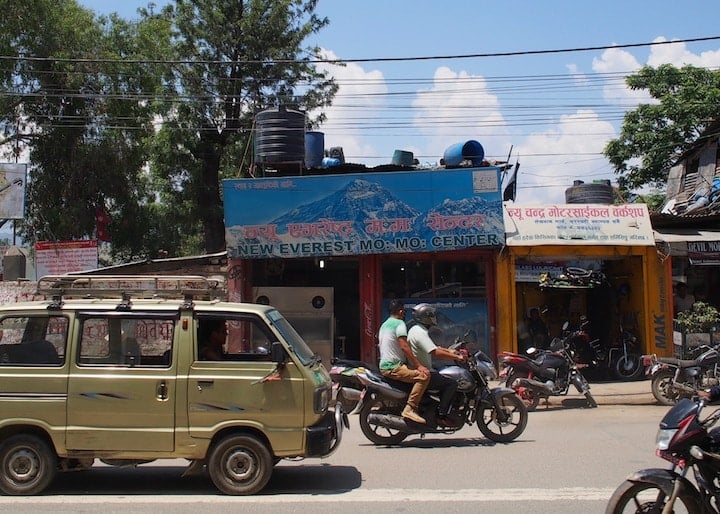
Anyone who has sought to know Kathmandu has a favorite momo spot. Just 24 hours earlier, I’d been certain that for all discerning locals this spot was New Everest Momo Center, where they serve one item: jhol (soup) momos of buffalo meat bathed in a mind-blowing house sauce. A plate of ten goes for 80 rupees (about 75 cents). The buffalo meat is well-seasoned, and the noodle wrapping is tender, but it is all about the jhol, here a blend of cheese, cilantro, chili, and unknowns. A good jhol is everything in the momo game. At New Everest, the man holding the plastic pitcher of jhol refill is king.
Somewhat problematically if your time is limited, New Everest Momo Center has a lot of imitators. Perhaps it is this New Everest that has scraped refinement out of imitation, but it is hard to know for sure. Iterations of the New Everest Momo Center name are plastered above silhouettes of the mountain on dozens of momo shops around the city. This cannot be explained by chain branding or a dispute among owners. It is, to my understanding, simply verdure in the momo jungle. In a city not known for its web presence, in this cradle of historical reverence for the world’s highest peak, the New Everest name is not sufficient as an identifying agent. You need to know Kathmandu, or someone in it, to find the original New Everest Momo Center. To find the best. And each new momo plate leaves you wondering how much deeper you can go in your search for it.
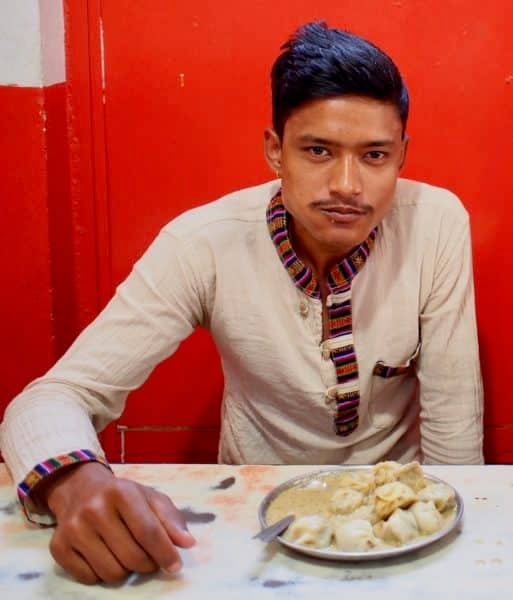
On this day, our taxi driver deposits us outside a one-room structure with walls painted mint-green in thick brush strokes. “Babuch”-something, he says, pointing inside, and I realize he is offering us the name of the place. I immediately forget what he says, but our meeting, like many others so far in Nepal, has already been logged favorably in the non-verbal language of unstructured travel. Inside, “Babuch”-something looks a little less like a bus station than our earlier momo stops, which I note. The jhol, from the entrance, looks to be in the New Everest style.
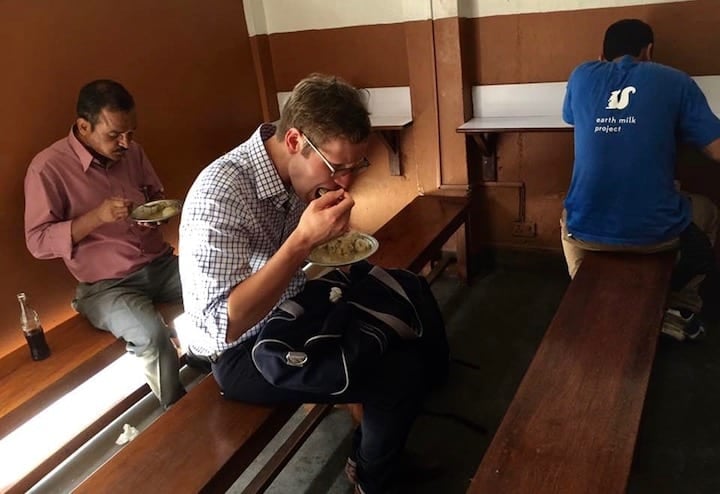
Momo loyalties are built in the subtleties of a jhol because the momo itself—whether drowned in jhol, fried or spiked with chiles (“C momo”)—is just a dumpling: meat wrapped in dough, cooked to be filling and for cheap. Momos wound of chicken, vegetables and rarely beef (undesired by a Hindu populace) are available in Kathmandu, but the favored in-city vendors use buffalo meat as a base, twisting into it flavors of the local earth (garlic, masala, chiles…), tying off ping-pong-ball-sized chunks in moist dough, and finally steaming them by the hundreds. A single order returns a plate of ten.
The momo likely crossed the frosty Himalaya some decades ago from Tibet, eventually rolling end over end into the Kathmandu Valley (4,500 feet above sea level is a valley in Nepal) to fill the hungry bellies of a growing population. In a country still without a single McDonald’s (but with a Yac Donald’s), momos are today the go-to fast food of the people, one in four of whom lives below the poverty line. Prior to the 2015 earthquake, that line hung low even by the standards of Southeast Asia. In its wake, things have gotten worse. The broken brick of devastation lies victorious three years later even at major tourist checkpoints like Kathmandu Durbar Square. Efforts toward rehabilitation finally have momentum, but in recent years the Nepali spirit has been forced, out of necessity, to buoy its people more than ever.
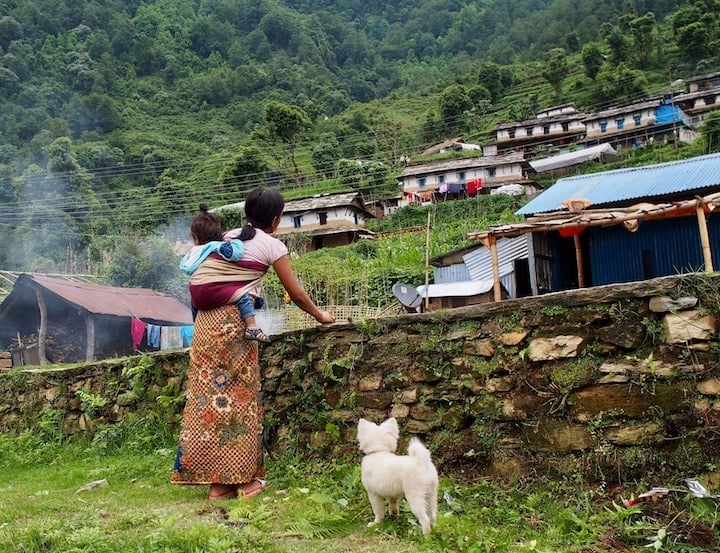
The eyes that befall us at “Babuch”-something are not the first to notice our steps into this post-earthquake Nepal. Though it is the government hosting the Himalayan Travel Mart, its constituents have embraced us as friends since our arrival, including in the dank and dilapidated momo joints of 2018 Kathmandu. Nepalis, I am learning, speak softly but smile wide. Because the mighty Himalaya get first billing in travel brochures, it is of note that Nepal’s summiting industry rests upon the muscled shoulders of the diminutive and big-hearted Sherpa people, with whom international summiters share months-long expeditions toward higher meaning. Ascension into the Himalaya’s Annapurna range, to that point, winds around sign after colorful sign bellowing for Nepal in acrostic: “Never End Peace And Love.” After my own Annapurna trek, I decided that the mantra must pre-date the signs.
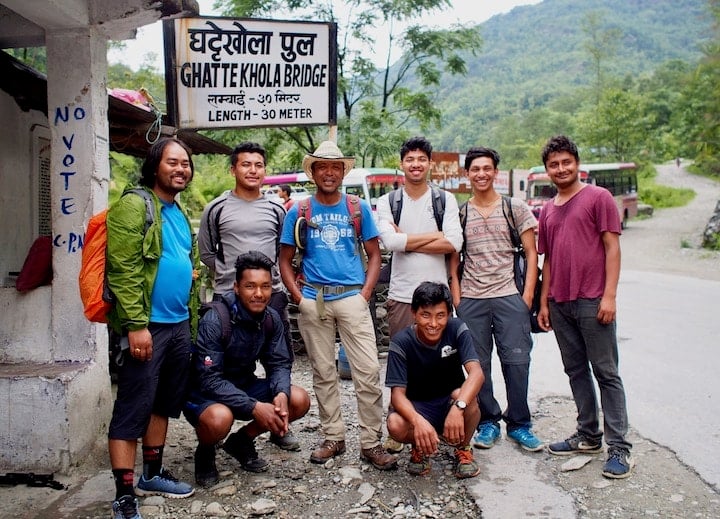
Inside “Babuch”-something, the reception is all love. Silver trays lipping with house jhol clink against one another as we slip our orders in. “Two momo,” we tell the proprietor who approaches, smiling but without a word. Soon after, we are seated, ushered into a rickety booth by a group of six young Nepali men. They seem impressed to find us here. One channels our cab driver and says, “Best momo,” with a point at our steaming plates. These ten-plus momos are delicious but perhaps not as good as those at the original New Everest Momo Center. In fact, New Everest Momo Center may have already lost its top spot at our last stop: Shandar Momo, from which we have just come. Shandar Momo—the watering hole of a conference organizer who described its location as “near Bharosa Hospital”—was fantastically good. Buffalo momos pooled in fiery red jhol. But, on second thought, was it really better than New Everest? We sit as if drowning in jhol and think on it.
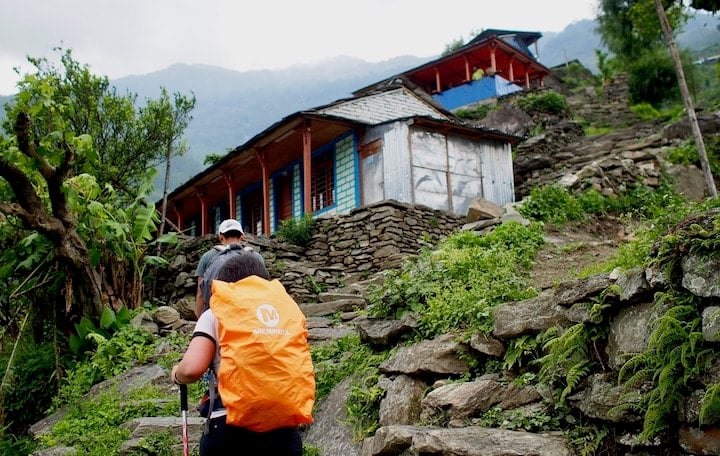
At the time of this writing, the U.S. dollar trades at about 110 Nepalese rupees. A plate of ten momos in Kathmandu goes for about the same price. You can’t walk a Kathmandu city block without passing a momo joint puffing steam heat into the street, and above street level, upscale hotels like the Kamalpokhari district’s Traditional Comfort (opened in late 2016) sell momos in their restaurants. Higher still, where trekkers look mostly to hearty dal bhat (rice and a lentil-based soup) for fuel in the thinning air (“dhal bat power, 24 hour,” in the words of my Royal Mountain guide), the tea houses of the central Himalaya make momos—always momos—available.
In June, the Himalayan Travel Mart returned for its second year, again with the intention of turning industry heads toward Nepal in a time of relative need. Again it was made clear that the country’s promise as a travel destination does not lie only in its well-oiled trekking mechanism. Momos, and the recipes that make locals smile widest, are part of a fuller portrait of Nepal, this place of “Never End Peace And Love.” The momo experience is the Nepal experience.
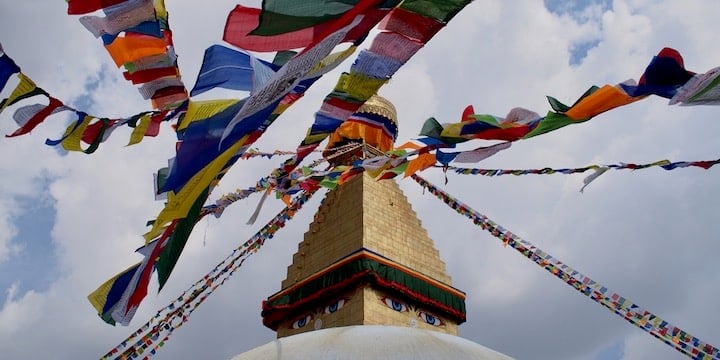
As Cathy and I consider this in our booth at “Babuch”-something, the wooden support behind us creaks. Midday is transitioning into afternoon. People are slurping more than talking around us as we attempt to recall the name of the roof above our heads to assign it a ranking, to script it a permanent place in the blueprint from which we are building a Nepal to miss. Across the room, “Shandar Momo” is painted in English in a deep red. This does not make a lot of sense to us. First, it does not at all resemble the name provided by our driver, he who chose this place above all others. Second, we have already eaten today at a place called Shandar Momo, and there is to our American eyes nothing similar about the two. No matter. Our official ranking will have to wait, maybe forever, but our mission has been accomplished. At the 60-momo mark, I am tapping out for the day. I know by now that I will return for more. For Cathy, at the 20-something mark it is the same. The hunt will continue another day, on our return to the land of the momo.
For more on travel to Nepal, visit welcomenepal.com. For more on flights to Nepal from the U.S., visit airindia.in. For more on the Himalayan Travel Mart (2019 dates not set), visit htmnepal.com.





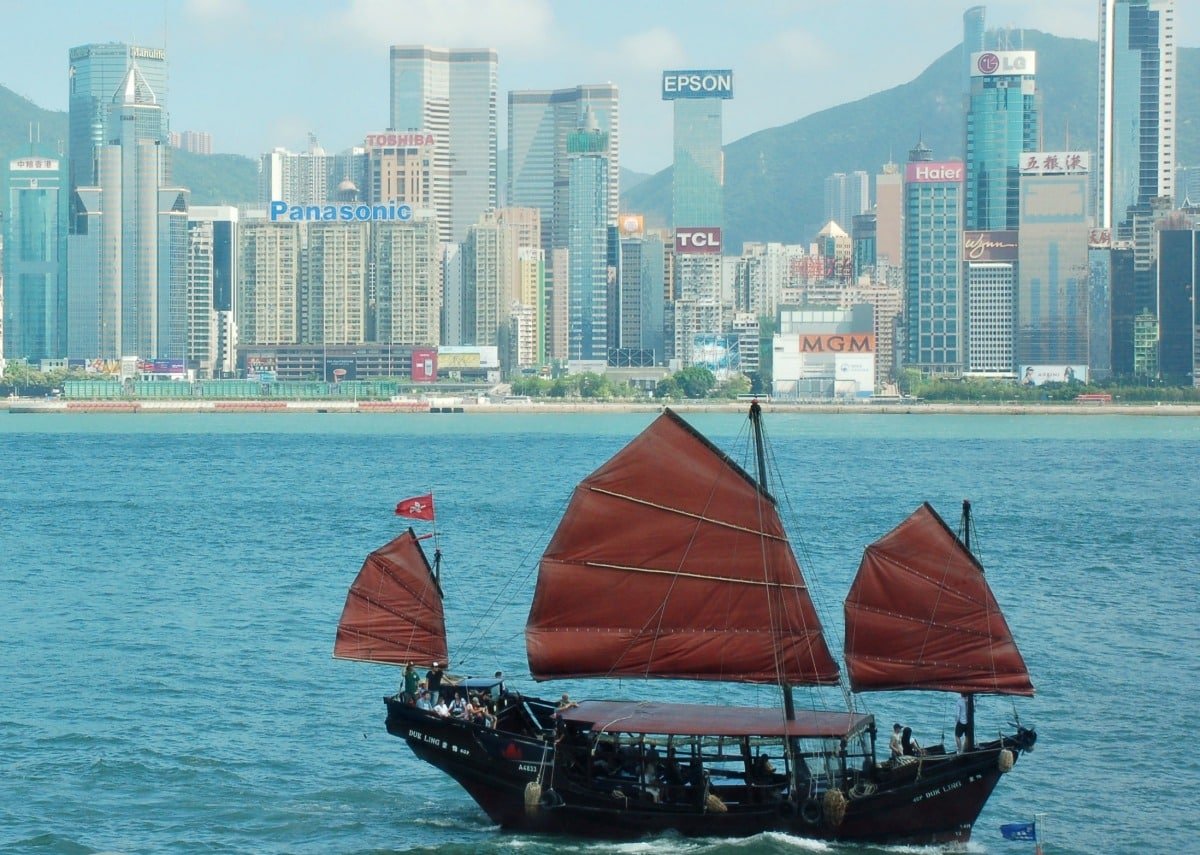

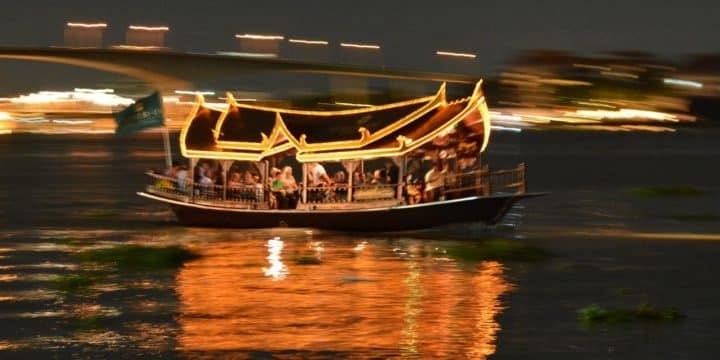
I am absolutely hooked on Momo’s and would love to try the real ones from Nepal. My experience is limited to the Momo Bar in my beach suburb in Sydney, Australia!!
Wow! great writing and thank you very much for sharing your Nepal experience. Yes, Momo is one of the best in Nepal.
Trekking and Tour Company in Neppal
Hi Ian,
Just stumbled upon your post on Momos In Nepal. Great writing. Furthermore, the combination of your momo experience with the descriptionof place is flawless.
Being a travel agent and also a Nepal travel blogger, your exuberance reflects through your article.
You may check-out my Nepal blogs @ https://www.yakkytours.com/blog/
Keep on the good work.
Cheers:)
Besides mo:mo you can choose from a variety of cuisine from the local communities of ceratin place.
Hello Ian,
Very Informative. Great writing.
I hope you had a great stay in Nepal.
And Momos in Nepal are actually the real deal since people are hooked to its taste, and its availability is something you can never question.
Furthermore, If you ever planned to revisit Nepal, I would like to manage the trip for you.
You visit my website: http://www.highlandernepal.com/
I hope to collaborate with you soon.
Thank you!!
The Momos taste great for sure… If you’re looking for an amazing adventure, Annapurna trekking https://asian-trekking.com/annapurna-trekking-an-amazing-adventure/ is for you. The target group of the expedition can be both experienced trekkers and beginners, but the latter should be physically fit for the long and strenuous walks, and also ready for other issues. The Annapurna Trek is the must-see in Nepal!
Momos are a type of dumpling that is popular in Nepal and other parts of the Himalayan region. They are made with a thin layer of dough filled with various ingredients, including minced meat, vegetables, cheese, and spices. Momos are typically steamed and served with a spicy sauce. They are a staple food in Nepal and are enjoyed by people of all ages. Momos are often sold as street food, but they can also be found in restaurants and are popular food items for special occasions and festivals.
Don’t miss Momos when you will be in Nepal. Let’s try it with the best trekking agency in Nepal